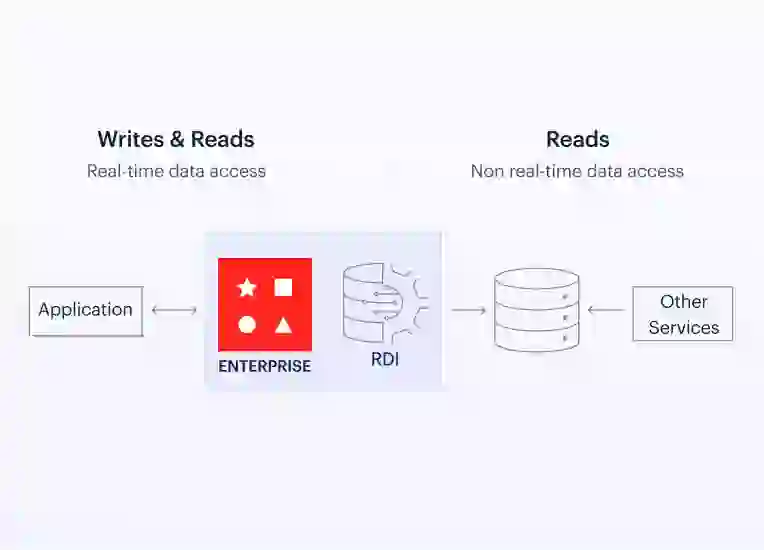We don’t just help you build fast apps. We help you do it fast. That’s why we’re excited to announce that Redis Data Integration (RDI) has arrived for Redis Software (with Redis Cloud soon to follow).
RDI is our tool built to synchronize data from your existing database into Redis in nearly real-time. We’ve done the heavy lifting, so your apps will run faster without investing significant time, effort, and money into building your own data pipeline. With RDI, you can turn slow data into fast data, scale without limit, and stop wasting money on database costs—all without needing to write code.
The problem with slow data & why companies turn to us
It’s a common problem: slow and expensive databases are often legacy linchpins in companies’ tech stacks, holding back the development of fast and scalable apps. And because these databases power mission-critical apps and business processes, re-architecting them is risky and disruptive.
To break free from this restraint, many companies turn to Redis. Some use Redis for caching while others go beyond and use Redis as a platform for real-time vector search, event streaming, feature storage, or as a primary database. Until now, most dev teams have relied on using a cache-aside pattern to get their data into Redis, but this introduces challenges of its own. Cache-aside often leads to problems with stale data or cache misses, resulting in data being fetched from slower databases and lengthening overall response times. However Redis is used, to get the most out of it, they need a robust and efficient method to get data into Redis and keep their data in sync between their source databases and ours. This is where the rubber meets the road: setting up a streaming pipeline to automatically capture changed data, ingest it, and transform it from its original database schema into a Redis-compatible format.
Some have attempted constructing a streaming pipeline from the ground up, but the complexities, resource drain, and costs of swift and scalable apps were daunting—until now.
Make slow data fast—at any scale
Break free of the speed and scalability limitations of your database and build fast, scalable apps. With RDI, you can now seamlessly use the speed of Redis alongside your existing databases to get fast, scalable, modern app performance.
RDI creates a data streaming pipeline that mirrors data from an existing database into Redis. The result: apps can access data really, really fast.
It does this by integrating slow databases with Redis to perform data ingestion and transformation to the Redis schema.
Once your apps are in Redis, they can access the fast data they need. And because your full dataset is in the format your app needs, you can also query your data directly in Redis in real time.
Sync data and work simply
RDI makes fast apps possible by keeping data in sync with configuration, not code. You can avoid the resource drain of teams manually building data pipelines to capture, ingest, and transform changed data from databases into Redis. With automated configuration, RDI ensures seamless data synchronization, so Redis and your database are always in sync. And to make your life even easier, you can soon use Redis Insight with RDI to operate and visualize your data pipeline.
Using RDI and Redis Insight together, you can streamline your pipeline creation process—seamlessly deploying pipelines from within Redis Insight, performing code completion and syntax validation, validating transformation and pipeline output, and monitoring data flow and pipeline performance in an intuitive dashboard.
Cut database costs with Redis Data Integration
RDI opens the door for many businesses who want to modernize their apps, but are struggling with cost-prohibitive database expenses. Typically, to modernize, companies face replica sprawl and expensive licensing fees.
Now, instead of paying for expensive read-replicas, RDI allows you to offload reads to Redis, which is a much more cost-effective way to get fast and reliable data access. This means you can provide predictable, high-speed data to the many microservices and apps that need real-time data.
Forget the days of spending dev time building a data pipeline or spending a fortune on third-party commercial data integration tools.
See how RDI overhauled Axis Bank’s customer experience
Replicating data into Redis using RDI made Axis Bank’s overall user experience 4.25X faster, eliminated 100% of customer complaints, and saved $82,000 in reduced database footprint.
Axis Bank Limited is a top Indian multinational banking and financial services institution based in Mumbai. As India’s third-largest private sector bank by assets and fourth-largest by market capitalization, they bring a wide range of financial services to a wide client base.
Axis Bank’s mobile app was supposed to let users see all of their latest account info, including the changes in the products they use and people they authorize to access their account. But when customers were making these changes offline at the branch, they weren’t being reflected in the app—which had an infrastructure based on a traditional relational database at the time. As expected, this lack of reliable, real-time data led to customer complaints and dissatisfaction in UX.

To fix this, they decided to use Redis for their mobile app to read from—but they still needed a simpler way to sync the data from their primary database. With RDI, Axis was able to simply ingest relevant records into Redis without complex code or expensive ETL tools. They can instantly capture and process real-time changes in data from nine large primary database tables. This means they can provide an impressive 4.25x faster response time, compared to retrieving data directly from core banking tables—which is a huge improvement in system performance and overall efficiency.
Want to start building faster apps using RDI? Talk to sales.
Additional Resources
The post Redis Data Integration, now GA appeared first on Redis.
 8 months ago
59
8 months ago
59


